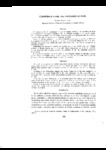| dc.contributor.author | Miranda Colín, Salvador | |
| dc.date.accessioned | 2013-05-02T22:26:55Z | |
| dc.date.available | 2013-05-02T22:26:55Z | |
| dc.date.issued | 1969 | |
| dc.identifier.citation | Miranda Colín, Salvador. 1969. Competencia entre tres variedades de frijol. AGROCIENCIA Vol. 4. Núm. 1. 1969. pp. 123-131 | en_US |
| dc.identifier.issn | 1405-3195 | |
| dc.identifier.uri | http://hdl.handle.net/10521/1925 | |
| dc.description | AGROCIENCIA Vol. 4. Núm. 1. 1969. pp. 123-131 | en_US |
| dc.description.abstract | El presente estudio de competencia se puso en marcha utilizando tres variedades de frijol con características agronómicas semejantes. De los resultados obtenidos en la segunda generación se deduce que dichas variedades tienen diferentes valores de adaptación bajo las condiciones ambientales que se presentaron en Chapingo en 1968. Según los cálculos realizados, la variedad Puebla-194 es el mejor competidor y eliminaría a la variedad Puebla-305 en la décima generación y a la variedad Michoacán-128 en la quincuagésima generación, bajo condiciones ambientales semejantes a las que se presentaron en Chapingo en 1968. Considerando la información anterior se concluye que si esta mezcla fuera una variedad sintética, se debería renovar por lo menos cada cuatro generaciones con el fin de conservar en una proporción más o menos constante los genotipos de las variedades integrantes de la mezcla. Finalmente, se demuestra que la duración de una variedad sintética es limitada, a menos que las líneas o variedades que la integran tengan un valor de adaptación similar para las diversas condiciones ambientales donde se cultive la variedad. ABSTRACT: This study of competition was started using three varieties of beans with similar agronomic characteristics. From the results obtained in the second generation it is deduced that such varieties have different values of adaptation under the environmental conditions at Chapingo in 1968. According to the calculations realized, the variety Puebla 194 is the best competitor; it would eliminate the variety Puebla 305 in the tenth generation and the variety Michoacan 128 in the fiftieth generation if the environmental conditions were similar to those at Chapingo in 1968. Considering the above information, it is conclued that if the mixture were a synthetical variety it should be renewed every four generations at least in order to keep a more or less constant proportion of the genotypes of the three varieties that integrate the mixture. Finally, it is demostrated that the life of a synthetical variety is limited unless its components have similar value of adaptation for different environmental conditions where the variety is cultivated. | en_US |
| dc.language.iso | spa | en_US |
| dc.publisher | Colegio de Postgraduados | en_US |
| dc.subject | Genética vegetal | en_US |
| dc.subject | Phaseolus vulgaris L. | en_US |
| dc.subject | Adaptación de las plantas | en_US |
| dc.subject | Competencia entre cultivos | en_US |
| dc.subject | Mezcla de semillas | en_US |
| dc.title | Competencia entre tres variedades de frijol | en_US |
| dc.type | Artículo | en_US |

